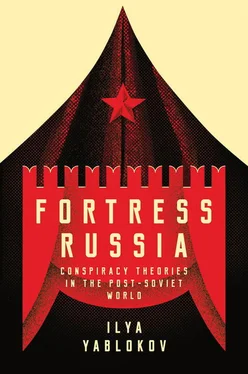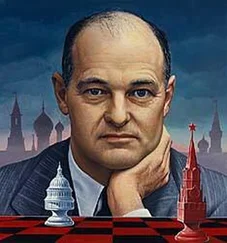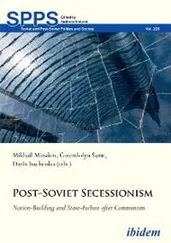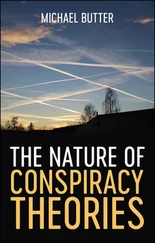Pavlov, a member of the GKChP , was arrested after the failure of the coup. In 1993, he published his own account of the events, in which he claimed that in mid 1991 the GKChP had been created by Gorbachev, Yeltsin and Gavriil Popov, then mayor of Moscow, to enable them to retain their power over the state; it was coordinated by the US president, George Bush (Pavlov, 1993, pp. 67, 79). Pavlov contended that the official version of events, which was actively promoted by Gorbachev and Yeltsin, was a cover for the real reason behind the attempted coup: these men’s lust for power. Pavlov’s account was published in 1993, soon after the shelling of the parliament building in October which led to many civilian deaths. He referred again to Yeltsin’s lust for power, accusing him of disregarding the interests and the lives of ordinary Russians:
Members of the GKChP by no means contemplated restoring dictatorship and repression. Moreover, the main thing for us… was the prevention of bloodshed, the unleashing of civil war and mass purges. Power was not my personal goal for which I would be ready to sacrifice the lives and blood of innocent civilians…. [Yeltsin] was ready to sacrifice thousands of lives to keep the office… (p. 70)
The attack on parliament gave some credence to Pavlov’s claim that Yeltsin’s regime was even more brutal than the GKChP. Taken together with his conspiratorial description of the August coup, the argument about Yeltsin’s brutality and the alleged backing of the United States became a powerful tool which could be used by the opposition to delegitimize the president.
Pavlov’s book is a particularly important element in the establishment of a conspiratorial interpretation of the coup. Pavlov was the first active member of the GKChP to offer an analysis of the coup; this ensured that there was an alternative reading of the event almost immediately. His insider’s view and elaborate arguments supplied the opposition with the necessary ‘factual’ basis for questioning Yeltsin’s legitimacy. The publication of his book in 1993 was also timely, since there was a significant growth in anti-Yeltsin feeling after the October atrocities. The conspiratorial interpretation of his actions during the 1991 coup helped to lay the grounds for an attempt to impeach him in 1998–9, and played an important part in transforming conspiracy theories into an instrument of mainstream politics.
Yeltsin’s Impeachment (1998–1999)
Yeltsin became the victim of conspiracy theories soon after becoming president in 1991. The opposition accused him of bringing about the demise of the USSR by signing the Belovezha accords, and of a ‘genocide of the Russian people’ by means of his economic reforms. The forces opposed to his government formed a loose coalition that was sometimes referred to as a ‘revanchist party’; in the first half of the 1990s, this brought together the Communists (Gennadii Ziuganov), national patriots (Vladimir Zhirinovskii and Aleksandr Prokhanov) and Russian fascists (Aleksandr Barkashov), all of whom subscribed to the notion of a war waged by the West against Russia (Yanov, 2010, pp. 192–4).
Gennadii Zyuganov, the leader of the newly formed Communist party of the Russian Federation, had seriously reconsidered the old Communist corpus of ideas to attract new supporters. He claimed that 1991 was the start of the New World Order which required the destruction of the United States’ major rival, the Soviet Union. In his view the Bilderberg club, the Trilateral Commission and the American Council for International Relations were building the new global order and were using the territories of Eurasia to put an end to Russia’s statehood and Orthodox Christianity (Zyuganov, 1997). As David Remnick notes (1998, p. 314), at the meetings in Washington with the US Ambassador to Moscow, or at the summits in Davos to which Zyuganov was often invited in the 1990s, Zyuganov kept quiet about his ideas. Yet inside Russia, at meetings with supporters or on television, he repeated them constantly.
After the parliamentary elections in December 1993, a considerable number of representatives of the ‘revanchist party’ were elected to the State Duma where they had the opportunity to legitimately use anti-Western conspiratorial rhetoric in political struggles against Yeltsin’s government. The zenith of these struggles was an attempt, in May 1999, to impeach the president; this was initiated by Iliukhin, who had unsuccessfully tried to put Gorbachev on trial for the same reasons in November 1991. The parliamentary commission, headed by Vadim Filimonov, a deputy from the Communist Party, levelled five charges at Yeltsin: the demise of the USSR, the shelling of the parliament building in October 1993, the war in Chechnia, the deterioration of national military defence and the genocide of the Russian people. At least four of the five charges contained elements of a conspiracy theory about an attack being carried out by Yeltsin, the Western European countries and the USA against the Russian people.
According to those trying to bring about the impeachment, the signing of the Belovezha accords by Yeltsin should have been treated as high treason; this was an organized conspiracy to seize power in the USSR and change the constitution. The accords were signed despite the results of a national referendum, which was conducted on 17 March 1991, which supported the preservation of the Soviet Union. The Belovezha accords impacted on Russia’s defence potential, and Yeltsin’s policies fit the geopolitical interests of the USA and were ‘rendering help to foreign countries to the detriment of the external security of the Russian Federation’ (Kommersant, 1999c).
It is important to stress that the accusation of treason made against Yeltsin was based on the notion that technically the President of Russia did not have the right to sign the Belovezha accords, and by doing so he had breached Soviet law; this meant that he had forfeited his right to rule. Both the dissolution of the USSR and the shelling of the parliament building in 1993 violated article 64 of the Criminal Law of the USSR:
The actions of B. N. Yeltsin in the organization of conspiracy, aimed at the seizure of power in the Union, had a conscious, purposeful character. As part of the preparation for the destruction of the USSR, B. N. Yeltsin issued several decrees, which overreached the bounds of his constitutional authority and aimed at the usurpation of Union power. (Kommersant, 1999c)
This claim cast doubt on Yeltsin’s legitimacy and emphasized his ‘otherness’ in relation to ‘the people’ of Russia. Iliukhin, as the initiator of the impeachment, based his speech on the corpus of conspiracy theories about the Soviet collapse which had been developed in the 1990s. As he put it:
The Soviet Union collapsed not because of natural processes, not as a result of the August 1991 events, but as a result of political conspiracy on the part of the ‘fifth column,’ with the connivance, and at times with the participation, of the president of the USSR M. Gorbachev and leaders of several Union ministries and agencies, and as a result of a conspiracy headed by B. Yeltsin. (Iliukhin, 1999)
It is certainly the case that the signing of the Belovezha accords was not entirely legal. As Lilia Shevtsova has observed, the Soviet Union was dissolved by the decision of a handful of political leaders who ‘were not concerned about the legality of their actions’ (Shevtsova, 1999, p. 14). This circumvention of the law helped reinforce the opposition’s claims about the ‘alien’ nature of Yeltsin in relation to the ‘Russian people’, whose desire to save the Soviet Union had been betrayed. Moreover, the fact that the US President Bush was the first person Yeltsin called after signing the agreement (Colton, 2008, p. 206) provided additional ‘evidence’ of a conspiracy between the Russian and US Presidents.
Читать дальше
Конец ознакомительного отрывка
Купить книгу












